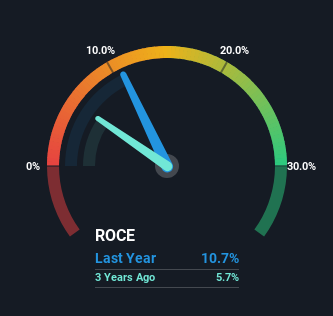- Brazil
- /
- Transportation
- /
- BOVESPA:SIMH3
SIMPAR (BVMF:SIMH3) Is Looking To Continue Growing Its Returns On Capital
Did you know there are some financial metrics that can provide clues of a potential multi-bagger? Ideally, a business will show two trends; firstly a growing return on capital employed (ROCE) and secondly, an increasing amount of capital employed. Ultimately, this demonstrates that it's a business that is reinvesting profits at increasing rates of return. So when we looked at SIMPAR (BVMF:SIMH3) and its trend of ROCE, we really liked what we saw.
Understanding Return On Capital Employed (ROCE)
For those that aren't sure what ROCE is, it measures the amount of pre-tax profits a company can generate from the capital employed in its business. The formula for this calculation on SIMPAR is:
Return on Capital Employed = Earnings Before Interest and Tax (EBIT) ÷ (Total Assets - Current Liabilities)
0.11 = R$5.5b ÷ (R$63b - R$11b) (Based on the trailing twelve months to September 2023).
So, SIMPAR has an ROCE of 11%. That's a pretty standard return and it's in line with the industry average of 11%.
See our latest analysis for SIMPAR

Above you can see how the current ROCE for SIMPAR compares to its prior returns on capital, but there's only so much you can tell from the past. If you'd like to see what analysts are forecasting going forward, you should check out our free report for SIMPAR.
The Trend Of ROCE
We like the trends that we're seeing from SIMPAR. The data shows that returns on capital have increased substantially over the last five years to 11%. Basically the business is earning more per dollar of capital invested and in addition to that, 342% more capital is being employed now too. So we're very much inspired by what we're seeing at SIMPAR thanks to its ability to profitably reinvest capital.
Our Take On SIMPAR's ROCE
In summary, it's great to see that SIMPAR can compound returns by consistently reinvesting capital at increasing rates of return, because these are some of the key ingredients of those highly sought after multi-baggers. Investors may not be impressed by the favorable underlying trends yet because over the last three years the stock has only returned 6.9% to shareholders. Given that, we'd look further into this stock in case it has more traits that could make it multiply in the long term.
Since virtually every company faces some risks, it's worth knowing what they are, and we've spotted 2 warning signs for SIMPAR (of which 1 is significant!) that you should know about.
For those who like to invest in solid companies, check out this free list of companies with solid balance sheets and high returns on equity.
New: Manage All Your Stock Portfolios in One Place
We've created the ultimate portfolio companion for stock investors, and it's free.
• Connect an unlimited number of Portfolios and see your total in one currency
• Be alerted to new Warning Signs or Risks via email or mobile
• Track the Fair Value of your stocks
Have feedback on this article? Concerned about the content? Get in touch with us directly. Alternatively, email editorial-team (at) simplywallst.com.
This article by Simply Wall St is general in nature. We provide commentary based on historical data and analyst forecasts only using an unbiased methodology and our articles are not intended to be financial advice. It does not constitute a recommendation to buy or sell any stock, and does not take account of your objectives, or your financial situation. We aim to bring you long-term focused analysis driven by fundamental data. Note that our analysis may not factor in the latest price-sensitive company announcements or qualitative material. Simply Wall St has no position in any stocks mentioned.
About BOVESPA:SIMH3
SIMPAR
Provides light vehicle rental, and fleet management and outsourcing services in Brazil.
Undervalued with reasonable growth potential.
Market Insights
Community Narratives



